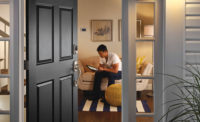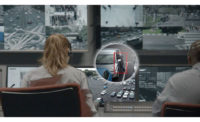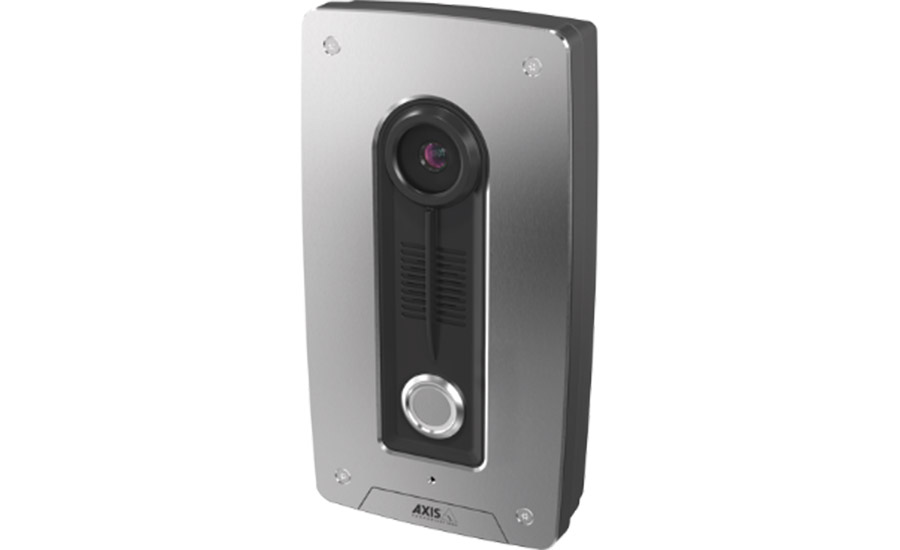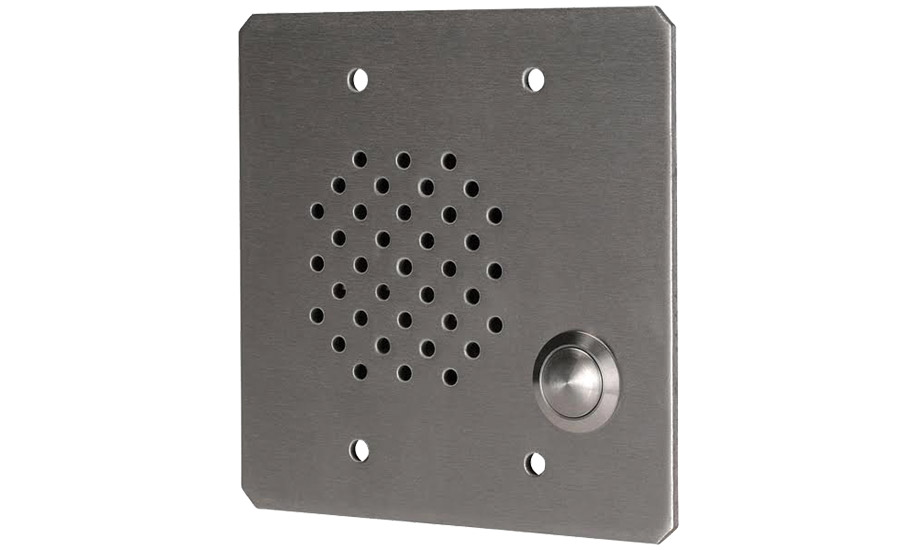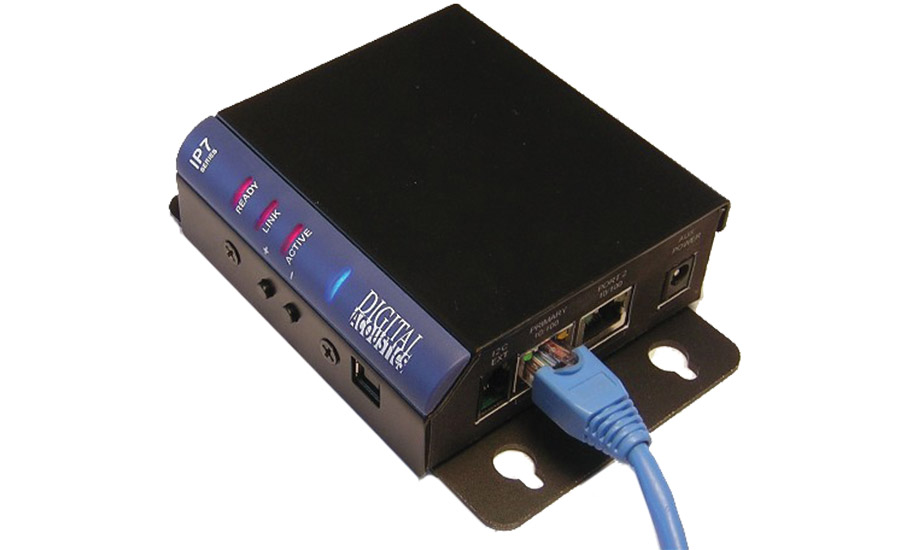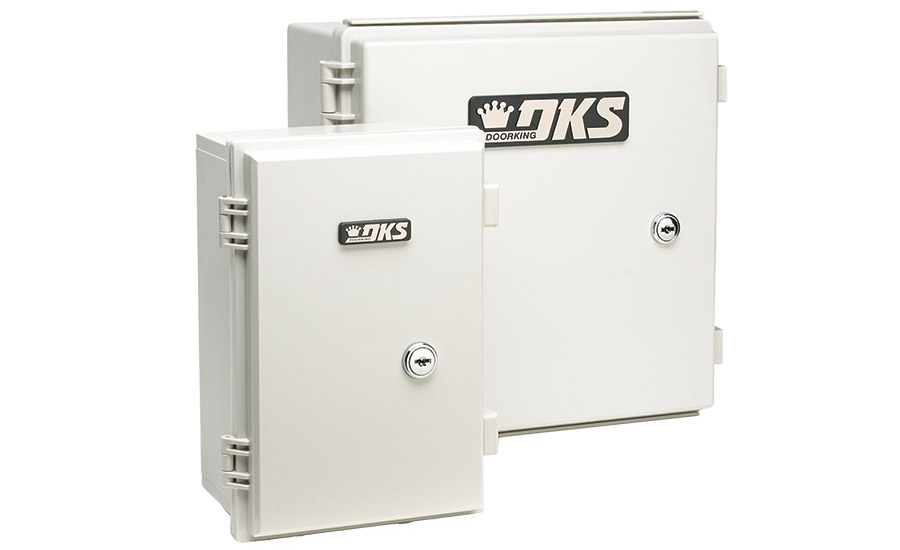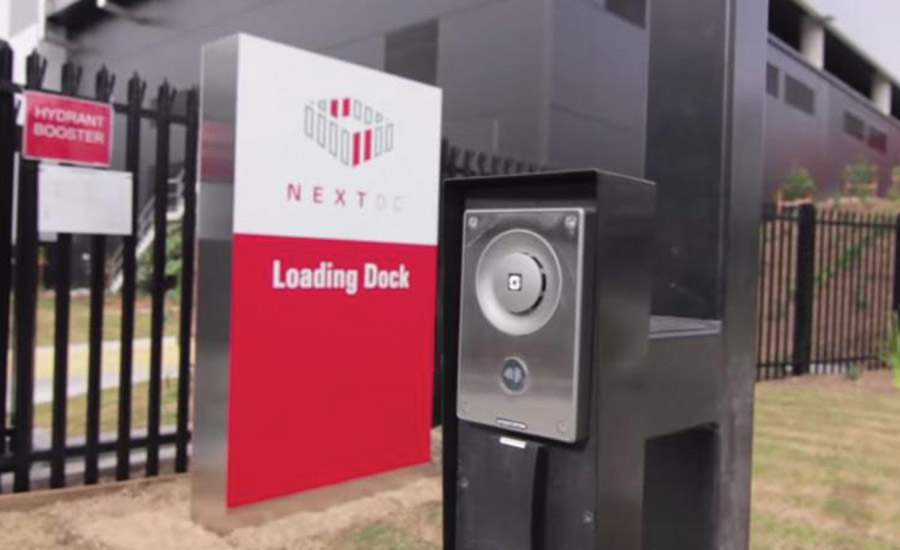Entry Control’s Expanding Role in the Connected Environment
The traditional push-to-speak entry control has been around for years, but with cellular and IP technology becoming so widespread, entry controls are playing an increasingly larger role in a building’s security and connected environment.

Companies that didn’t traditionally spend much money or time developing entry control systems are now looking to integrators to come up with a plan for an effective and efficient entry control system. PHOTO COURTESY OF AIPHONE

IP and cellular technology is allowing customers to see and hear who is at the door, to open the door, and to do so in a variety of ways. Photo COURTESY OF AIPHONE

Entry gates of car parks and toll roads are particularly difficult points to have a conversation due to the noise of idling car and trucks. Suppressing that noise with noise cancelation makes these conversations much easier. PHOTO COURTESY OF VINGTOR STENTOFON

Zenitel USA practices what it preaches and utilizes its TCIV-3 Turbine IP compact video intercom substation at the front door entrance of its U.S. headquarters in Kansas City, Mo., for visitor management purposes. PHOTO COURTESY OF VINGTOR STENTOFON

AXIS A8004-VE network video door station is an open, non-proprietary, IP-based door station for two-way communication, identification and remote entry control. It is designed to be a robust outdoor unit with a high-performing intercom function, providing clear, uninterrupted and echo-free speech in the most demanding situations.
Visit www.axis.com for information.

THE DIGITAL ACOUSTICS’ IP7-FD-CIS4 is an IP-enabled, PoE-capable, two-gang, vandal-resistant call panel designed for full-duplex two-way audio with door control. As a network edge device, the IP7-FD-CIS4 is quickly installed and configured using CAT 5/6 cabling from a PoE network switch using Digital Acoustics’ TalkMaster software. Quick installation into standard two-gang electrical boxes provides reliable two-way full-duplex voice communication as well as tones and background music. The heavy-duty stainless-steel panel is designed to provide years of service in a wide range of environments, high intelligibility from a 2.5-in. speaker and dedicated microphone, and a hardened, flush-mount design for demanding indoor/outdoor environments.
Visit www.digitalacoustics.com for information.

The Digital Acoustics’ IP7-FD-CIS4 is an IP-enabled, PoE-capable, two-gang, vandal-resistant call panel designed for full-duplex two-way audio with door control. As a network edge device, the IP7-FD-CIS4 is quickly installed and configured using CAT 5/6 cabling from a PoE network switch using Digital Acoustics’ TalkMaster software. Quick installation into standard two-gang electrical boxes provides reliable two-way full-duplex voice communication as well as tones and background music. The heavy-duty stainless-steel panel is designed to provide years of service in a wide range of environments, high intelligibility from a 2.5-in. speaker and dedicated microphone, and a hardened, flush-mount design for demanding indoor/outdoor environments.
Visit www.digitalacoustics.com for information.

DOORKING’s cellular connection service provides not only voice communication for the entry system, but also uses the cellular network for all programming functions. The DKS system uses true machine-to-machine (M2M) language for programming, allowing users to program their DKS entry systems just as they always have in the past. All they need is an Internet connection and the DoorKing programming software, which is available as a free download from the company’s website. Ethernet cables or other data wiring is completely eliminated.
Visit www.doorking.com for information.

The Vingtor Stentofon Turbine TCIS-2 features HD voice quality, open duplex, active noise cancellation, MEMS microphone and a 10W Class D amplifier. It has a stainless-steel front plate with one button, is dirt-, dust- and water-resistant with an IP-66 rating, and has active noise canceling. It also supports a wide set of IP and network standards and is designed to be ideal for building security and public environments.
Visit www.zenitel.com for information.









The world of entry control is evolving with technology and changing user behavior. Buildings such as elementary schools that didn’t traditionally spend much money or time developing entry control systems are now looking to the security integrator to come up with a plan for an effective and efficient entry control system. “There is a growing awareness for the need of controlling access into premises,” says Samuel Shanes, CEO of Talkaphone, Niles, Ill. “Whether it is a dormitory or entrance to a business or an equipment closet, you have to know who and what is going in.”
That need for higher quality video at doorways is driving the market for IP video door stations, says Bruce Stewart, business development manager, access control, Axis Communications Inc., Chelmsford, Mass. “IP video door stations can easily replace an older analog solution or black-and-white camera.” This technology, says Stewart, allows for integration into the broader connected environment. “We are seeing Axis video door stations being integrated into enterprise solutions with video surveillance, access control, intrusion detection systems and IP telephony or VMS for a fully controlled and managed system.”
As IP grows in popularity, so also do customers’ expectations for entry control. “With IP today one has more choices to provide the ability to simply see, speak, and open a door in a variety of ways,” says Paul Rux, director of sales Latin America & South Central Region, USA Zenitel USA Inc., Kansas City, Mo. “We all live in a mobile society and have smartphones, tablets and laptops. With SIP [session initiation protocol] one now has the ability to push valuable real-time audio and video for more efficient and safer visitor control and access management.”
Rux says with this trend consumers are learning to maximize the IP backbone of their network. “Today’s security intercom buyer simply wants more choices to answer calls. Today’s intercom with video adds the eyes and ears of security and becomes an effective additional layer for one’s premises.”
Another thing driving cellular and IP technologies is the phone companies’ phasing out of copper POTS lines, says Richard Sedivy, director of marketing and regulatory affairs for DoorKing Inc., Inglewood, Calif. “Cellular has become very popular with the installation companies as it simplifies installation and saves them and their customers money. No trenches to dig, no wiring to run,” he says.
As high-resolution video becomes more universal in these systems, consumers have begun relying on video as a crucial part of entry control. “People not only want to see who they are letting in the door, but they want a high-definition image of the person,” says Mike Busby, marketing coordinator, Viking Electronics Inc., Hudson, Wis. “Another up-and-coming trend is being able to see and talk to the visitor on a smartphone.”
With the ability to control a company’s premises remotely, many companies are finding ways to circumvent traditional security methods in favor of more efficient, remote methods. Bruce Czerwinski, U.S. general sales manager, Aiphone Corp., Redmond, Wash., says another trend is an emphasis on the security of lobbies. “Many multi-tenant and commercial buildings are looking to save money by reducing the need for security guards — intercoms provide security 24/7.”
Shanes adds that people now want the ability to have the entry control device call a cellphone after hours so that no matter when visitors push the button, someone will be able to see and speak with them.
The move of many to IP and cellular technology is facilitating the broader uses of entry control. Customers can see the additional possibilities that come with the newer technology. “The feedback has been positive from integrators and customers,” Stewart says. “They’ve been impressed with the quality of audio and video.” Stewart says that some of the technologies his company is able to provide are wide dynamic range for difficult lighting issues as well as efficient noise cancellation for difficult installations where noise (gates, traffic, wind, etc.) could be an issue.
Like all technologies relying on IP, entry control requires the right amount of bandwidth to perform properly. In the case of audio, that generally isn’t an issue because quality audio over IP requires extremely little bandwidth, says Christopher McNicholas, vice president – sales, Digital Acoustics, Lake Bluff, Ill. While IP technology offers more flexibility for the customer and integrator, connectivity is the biggest factor, McNicholas says. “Sometimes, a network is already located near an entry. Other times, network access could be across a building, parking lot or across a city. Our platform has the ability to deal with all of these scenarios, so we can provide high-quality IP audio to your gate and back. In addition, it provides control signals to unlock a door and monitor opened/closed status via on-board sensor.”
Installers must be aware of the potential challenges going into a project in order to offer customers the most efficient system possible. Regardless of the environment, Shanes says there are several things a unit must have: durability, survivability and quality communications. “You’re going to be putting this thing out of doors; it’s going to be used over and over again, so you want it to be extremely intelligible — when a visitor says something, you want it to be clear,” he says. “And you want them to understand you. You don’t want them to feel like they’re being interrogated; you want them to feel like they’re being greeted, but I have to know who you are before I’m going to let you in.”
Rux advises installers to gather the proper information from customers before beginning a project. “Remember to know where it is going to be deployed and installed,” he says. “Do you want audio with door control, or audio and video with door control? Who is going to be using it? Does one want the control of the audio and door to come from an IP desk master, an IP phone attendant, soft virtual master, mobile device, smart device, an app?” Rux explains all of these choices can afford users the ability to hear, be heard and be seen. And if designed properly, they can open and release a door after visitor verification is made. “Know what’s under the hood and around one’s native IP and SIP devices, as not all are the same,” he continues. “Do you need IP 54 or IP 66? Do you need IK 8 or would IK 10 rating be better? How will it perform in extreme heat, cold and loud harsh environments?”
Busby says one of the biggest challenges his company has had is making its entry systems weather resistant. “We use Mylar speakers, special gaskets, sealed switches, and sealed LEDs to ensure water does not enter the chassis. The internal PC control boards are potted in durable thermoplastic for protection against condensation. Our push-button switches are custom designed — taking almost two years to develop. They feature internal seals, so the button will operate reliably, even in the harshest environments.”
From an integrator’s perspective, Matthew Arnold, president, Academy Mailbox, Hicksville, N.Y., agrees about the importance of finding quality products. “There are systems that are being imported from Europe,” he says, “But they could be made in substandard factories. The products need to be made up to specs. It is important to investigate who you’re getting it from.”
Of course wireless systems eliminate a large issue associated with traditional hardwired systems. “Location can be a challenge,” Sedivy says, “especially if network (Cat 5) cables need to be run. If there is more than one entry location, this further challenges wire runs and can get expensive. Wireless systems can simplify this.”
Nowhere is the need for durability and intelligibility more apparent than in industrial environments. To properly accommodate customers, Rux advises installers go to the actual potential jobsites to see how and where they are going to mount, and how they are going to get data and power in a particular industrial environment. “Not knowing this type of information can be potential margin killers. Simply put: Do your homework.”
High noise levels might require additional speakers at an entry location, Sedivy adds. And in certain environments, entry stations can pick up sound from multiple directions, Czerwinski says. “You can combat that with directional mics or noise cancelation. Weather can be an issue, especially severe cold. Buttons can freeze. Touchscreens may not work with gloves on, as with a mobile phone. We recommend using vandal-resistant stations, which tend to be less vulnerable to weather extremes.”
Busby describes a unique challenge Viking has contended with: “One of the most demanding applications for a hands-free phone is at a truck gate/entrance,” Busby says. “In this type of situation you have a driver trying to converse with someone while their loud diesel engine is running. Because our hands-free phones feature voice switching, we can use a very loud speaker without worrying about feedback.”
In this preparatory stage, Rux says it is important to be proactive in foreseeing technology issues. “When deploying native IP audio edge devices,” he says, “remember to get your IT and telephony departments involved early. It is just a simple port setting that can stop a project in its tracks.”
McNicholas adds, “A live construction site has constantly evolving access requirements (moving intercoms, moving gates, moving head-end/control). These challenges can be addressed with an IP/network base so functionality of the system can be easily reconfigured.”
There is no end to unique jobs and environments that require proper planning and careful network development. Academy Mailbox works exclusively in Manhattan, where Arnold says they occasionally work on buildings that have been designated as landmarks. “In a landmark building we can’t touch or mount anything on the outside — maybe even on the inside,” he says. In these situations they have been forced to glue rather than mount products, and they have to be careful the system does not break up the aesthetics of the façade.
Talkaphone did a project along the Trans-Alaska Pipeline, which spans 800 miles. “There are buildings at various points for storage of materials and for taking shelter,” Shanes says. “We built this equipment that allowed them to call for assistance and to gain access. But the ambient temperature we were told was -80 deg. F. in the winter. They needed a space maintained at 45 deg. F. We did that with heaters and fans, and we maintained it at 55 deg. F. just to be sure. We had to make it an unusual shade of green because they wanted to make sure the pipeline and anything we put up didn’t upset the habits of the caribou.”
Czerwinski says that installers should keep scalability in mind. “You need to always consider the possibility of system expansion,” he says. “Some lower-end, budget systems have tight limits on the number of doors or interior stations that can be connected. If an end user later wants to add devices, you may have no choice but to remove the existing system and replace it with a new one.”
Busby adds, “Look for entry systems that have the features people are asking for: quality, durability and affordability.”
And sometimes a good demo is enough to seal the deal, says Rux. “Show them and let them hear the difference.” Rux also advises installers add new tools to their belts and use open and scalable solutions that play well with IP and cellular.
Stewart says using IP video door stations that support SIP will allow integration with IP telephony and VoIP communication systems. “This possibility to forward sound and pictures further enhances the flexibility of any surveillance solution and makes daily operations more efficient. For facilities with a more complex security system (large retail stores, logistic centers, airports, university campuses, etc.) video door stations can be an attractive complement and cost-efficient way to improve surveillance.
Entry control is evolving and can greatly enhance an integrator’s offerings. As more companies look to secure their entryways and beyond, integrators should be prepared to offer them what they want in the most efficient, cost-effective way possible. n
PRODUCTS:

AXIS A8004-VE network video door station is an open, non-proprietary, IP-based door station for two-way communication, identification and remote entry control. It is designed to be a robust outdoor unit with a high-performing intercom function, providing clear, uninterrupted and echo-free speech in the most demanding situations. Visit www.axis.com for information.


The Digital Acoustics’ IP7-FD-CIS4 is an IP-enabled, PoE-capable, two-gang, vandal-resistant call panel designed for full-duplex two-way audio with door control. As a network edge device, the IP7-FD-CIS4 is quickly installed and configured using CAT 5/6 cabling from a PoE network switch using Digital Acoustics’ TalkMaster software. Quick installation into standard two-gang electrical boxes provides reliable two-way full-duplex voice communication as well as tones and background music. The heavy-duty stainless-steel panel is designed to provide years of service in a wide range of environments, high intelligibility from a 2.5-in. speaker and dedicated microphone, and a hardened, flush-mount design for demanding indoor/outdoor environments. Visit www.digitalacoustics.com for information.

DoorKing’s cellular connection service provides not only voice communication for the entry system, but also uses the cellular network for all programming functions. The DKS system uses true machine-to-machine (M2M) language for programming, allowing users to program their DKS entry systems just as they always have in the past. All they need is an Internet connection and the DoorKing programming software, which is available as a free download from the company’s website. Ethernet cables or other data wiring is completely eliminated. Visit www.doorking.com for information.

The Vingtor Stentofon Turbine TCIS-2 features HD voice quality, open duplex, active noise cancellation, MEMS microphone and a 10W Class D amplifier. It has a stainless-steel front plate with one button, is dirt-, dust- and water-resistant with an IP-66 rating, and has active noise canceling. It also supports a wide set of IP and network standards and is designed to be ideal for building security and public environments. Visit www.zenitel.com for information.
MORE ONLINE
To learn more about entry control, visit SDM’s website where you will find the following articles:
“IP and Cellular Technologies Have Revolutionized the Door Intercom or Telephone Entry System”
www.SDMmag.com/ip-cellular-intercom
“All ‘Ayes’ on Today’s Intercoms”
www.SDMmag.com/all-ayes-on-todays-intercoms
“Purpose Not Product Sells Entry Controls”
www.SDMmag.com/purpose-not-product
“Turbocharged Intercom Systems”
www.SDMmag.com/turbocharged-intercom-systems
Looking for a reprint of this article?
From high-res PDFs to custom plaques, order your copy today!




